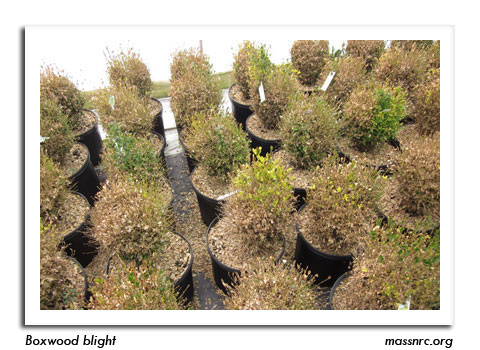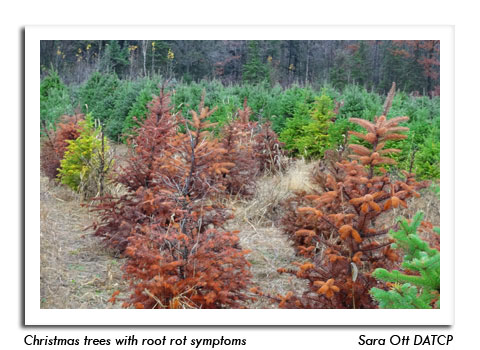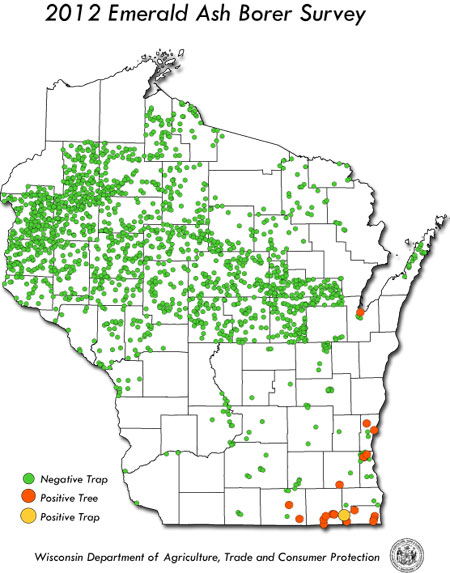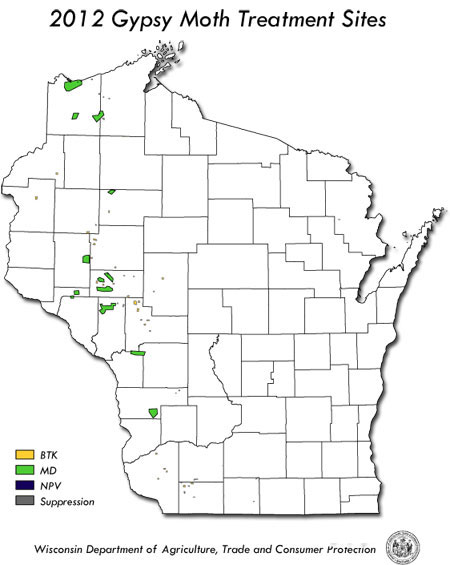
 |
|
|
Nursery & Forest
Volume 57 Number 21 Date 11/08/2012 VIRUS SURVEY OF ORNAMENTALS - The Plant Industry Laboratory conducted a survey for virus diseases of ornamentals last spring and found 47 of 110 (43%) samples collected to be infected with one or more viruses. The most common were tobacco rattle virus on bleeding heart and barrenwort, cucumber mosaic virus on a variety of hosts, and hosta virus X on hosta. A complete listing of the plants tested and viruses found is included in the August 2 issue of the Wisconsin Pest Bulletin. BOXWOOD BLIGHT - This new disease of boxwoods, caused by the fungal pathogen, Cylindrocladium pseudonaviculatum, was not diagnosed from any boxwood sample submitted to the Plant Industry Lab for testing this season. Some samples showing tip-dieback were found to have Phoma blight, Volutella blight or winter injury. Symptoms of boxwood blight include brownish leaf spots, distinctive black stem lesions, rapid defoliation and severe dieback. This fungal disease has not been confirmed in Wisconsin to date. PHYTOPHTHORA ROOT ROTS OF CHRISTMAS TREES - As of late October, 49 diseased Christmas tree samples have been received by the Plant Industry Lab for diagnosis. The samples were collected from Christmas tree fields by DATCP inspectors as part of a multiyear survey for new Phytophthora root rots. Thus far, four different Phytophthora species have been identified: Phytophthora cactorum, P. citricola, P. europaea and P. sansomeana. The latter two species are new to science and were first identified in Wisconsin on Frasier fir in 2011. In addition to Phytophtora, Armillaria root rot was also a cause of tree dieback in some of the fields. -- Anette Phibbs, DATCP Plant Pathologist JAPANESE BEETLE - After many successive years of high trap counts, the Japanese beetle trapping program was revised in 2012 and efforts were concentrated in nurseries with low densities of 20 or fewer beetles per trap (based on three years of trap data). This year's survey included 99 traps and yielded 16,292 beetles, or 165 per trap. High counts of 200 or more beetles per trap were registered in Dodge, Jefferson, Kenosha, Manitowoc, Monroe, Ozaukee and Waukesha counties, moderate counts of 50-199 per trap were found in Dane, Jackson, Rock and Washington counties, and 13 other counties averaged fewer than 50 per trap. The survey average of 165 beetles per trap represents a 30% decrease from 2011 when the average was 236 per trap and suggests Japanese beetle populations were somewhat lower this year. EUROPEAN PINE SHOOT MOTH - State nursery inspectors carried out a European pine shoot moth (EPSM) trapping survey for the first time this season, targeting nursery stock and Christmas tree growers who ship pines to California, Hawaii and Montana where external quarantines are enforced against EPSM. Approximately 32 moths were captured at two sites in Jackson and Rock counties. Surveys in Adams, Clark, Columbia, Marquette, Racine and Shawano counties were negative. REJECTED NURSERY STOCK - Ornamental plants and trees infested with regulated insects or diseases or that fail to meet pest cleanliness, labeling and quality standards are commonly found during routine nursery inspections. Such plants cannot be offered for sale in Wisconsin. Included in this category in 2012 were cherry trees with black knot, assorted herbaceous perennials with viruses, coneflower with aster yellows, speedwell with foliar nematodes and non-viable stock. In addition, a variety of trees and shrubs were rejected due to scale insect infestation and wood-boring insect damage. Also rejected this year were plants listed in the NR 40 Invasive Species Rule, such as autumn olive, Brazilian waterweed, blue lyme grass, curlyleaf pondweed, dame's rocket, glossy buckthorn, Japanese and Tartarian honeysuckle, purple loosestrife, red stemmed parrot feather, yellow floating heart and variegated porcelain berry vine. -- Liz Meils, DATCP Nursery Program EMERALD ASH BORER - The 2012 detection survey conducted by DATCP included 1,639 traps and resulted in the capture of 11 beetles on one trap in Kenosha County. Another two beetles were captured on a trap set by the DNR at Perrot State Park in Trempealeau County. All other traps were negative, although several infested trees were discovered in June in Brown, Rock, Walworth and Waukesha counties. Consequently, Rock, Trempealeau and Walworth counties were placed under quarantine, while Brown and Waukesha counties have been quarantined since 2009. Emerald ash borer has now been found in 13 Wisconsin counties: Brown, Crawford, Kenosha, La Crosse, Milwaukee, Ozaukee, Racine, Rock, Trempealeau, Vernon, Walworth, Washington and Waukesha. -- Becky Gray, DATCP EAB Program GYPSY MOTH - Larvae began emerging from overwintered egg masses as early as April 2 in response to unusually warm March temperatures. Aerial treatments started by April 26 and were completed on June 28. The DATCP Slow the Spread Program treated 45,284 acres with Btk, 3,606 acres with NPV (nucleopolyhedrosis virus), and 145,034 acres with pheromone flakes, for a total of 193,924 acres at 64 sites in 22 counties. The DNR Suppression Program also treated a 190-acre site at Governor Thompson State Park in Marinette County with Btk on May 17. Analysis of trapping program data revealed no significant change in the average number of moths per trap from 2011 to 2012. The annual survey registered an average of 9.5 moths per trap, compared to 9.4 last year. State moth counts were 173,588 in 18,293 pheromone traps in 2012 and 233,990 in 25,000 traps in 2011. The highest moth counts were reported from Ashland, Bayfield and Jackson counties, while none of the 52 counties trapped this summer registered zero moths. Additionally, the counties of Ashland, Bayfield and Clark, which now have established or breeding populations of gypsy moths, were added to the existing quarantine in 2012. The gypsy moth quarantine currently includes 48 counties in the eastern and central areas of the state. GYPSY MOTH DEFOLIATION - Larvae defoliated 14,500 acres of aspen and oak in northern Bayfield County this year, according to aerial surveys. A few large roadside oaks in Marinette County were also heavily defoliated. Reports from DNR Forest Health Specialists suggest larval populations are likely to be higher in 2013. -- Nkauj Vang, DATCP Gypsy Moth Program 





|
|
|